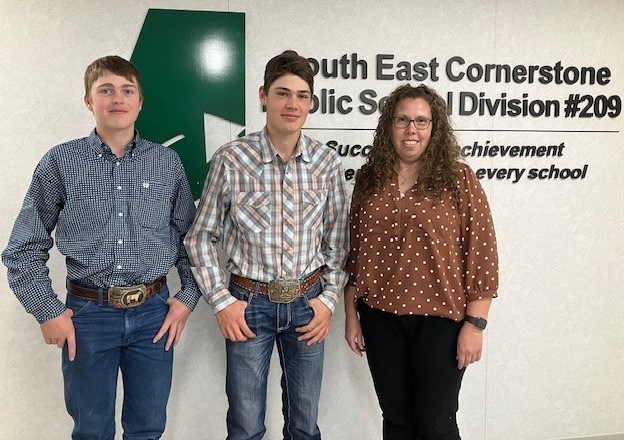WEYBURN - System Goal No. 2 for the South East Cornerstone Public School Division may appear to be somewhat grandiose since it calls for students to achieve at high levels.
But what the division’s board members heard and saw on Oct. 11 was a prime example of what might happen within this educational structure when young minds are let loose to explore and explain under the guidance of caring educators.
Encouragement from within the local communities also helps significantly and all those factors came into play when two young students from the Carnduff Education Complex made their presentation to the board during the board’s regular open business session.
Science teacher Jessica Morland introduced students Wyatt Thompson and Logan Stewart and provided an outline of their project. She said the duo has worked on a portable irrigation system that can address the needs for more efficient crop development not only in Canada, but globally.
Thompson and Stewart explained in some detail how their invention caught the eyes of judges at local science fairs and earned them a place at a Western Canadian science fair in Edmonton.
“We could only afford to enter one project and two students for Edmonton,” Morland said.
Purposes, hypothesis, procedures, data analysis and traditional uses were all displayed by the two, who entered the competition that featured over 30 other entries in the agriculture, fish and food category.
The portable system explains itself in its name. That means being able to move an irrigation system easily from quarter sections of land (or less) with little hassle, while covering 15 per cent more crop land once it is in place.
The movement of the equipment is made easier, thanks to a hydraulic telescopic system that allows for wheels that aren’t required for transportation to be lifted, while irrigation pipelines are reduced in size telescopically for easier delivery.
They addressed the problem of “how will this tie in with needs now,” said Morland, who brought posters of the invention while the two students showed the board members a model of what they hope to build into a prototype model for future experiments.
According to Thompson, the more flexible system allows water to reach “the corners” of cropped land that are always missed by traditional irrigation systems.
“It works the same as a central pivot model, but can navigate to the next field. The telescope system comes out and you can keep spraying. A six-section model can cover a quarter section of land," Thompson said.
The two young men said they were in contact with the Estevan-based Southeast Techhub and its mentor and leader, Gordon More.
When contacted by phone, More said he became aware of the project through the Cornerstone Science Fair.
“The project ticked so many boxes,” he said. “It said to me this was more than just a project, it was also what they are as people. I see potential in people and their product.”
In a geographic area that may not always be seen as being conducive to experimental growth in southern Saskatchewan, this project is one of several that have been uncovered, he said.
“We want to create a space for them, support the technology and provide the opportunity to support them as a community,” More added.
“People like that are the dreamers. They want to create and we have to nurture that.”
Choosing a product development that could potentially go globally is a positive factor, More added.
“With the chaos in climate, farmers need ways to get stabilization and I can see global potential. It’s more than Saskatchewan or Canada. There are other places in the world with problems you have to overcome as you design it to meet these problems.”
The oil and gas industries have provided several examples of advancement over the decades, he suggested.
“Interacting with them has been tons of fun,” More said.
Potential funding through grants or other means are now being explored, said Thompson and Stewart.
Board chairwoman Audrey Trombley said she was impressed with the positivity that was brought to the conference room by the Carnduff trio.
Based on More’s assessment, Thompson said they are more keenly aware of food shortage issues and proper land use in dry areas around the globe.
Stewart added that a GPS tracking system keeps users on target in the field, making for more efficacy in operations.
“We have to get this into a production stage, a working model,” said Thompson.
The trio also addressed concerns regarding patents, along with protecting their research and development at this stage.
“There is a lot more creativity out there that we are missing,” said Morland, in concluding the presentation.
She also had noted earlier that while she felt the irrigation system warranted further attention in the immediate future, the two young men had also developed and built a heavy lift model they called the Quick Lift, that could operate in tight spaces where traditional machinery such as forklifts couldn’t get into.




